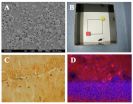Siblings of children with autism can show signs at 18 months
2014-10-20
(Press-News.org) About 20% of younger siblings of children with Autism Spectrum Disorder (ASD) will develop the condition by age 3. A new study by Yale School of Medicine researchers has found that 57% of these younger siblings who later develop the condition already showed symptoms at age 18 months.
Published in the October Journal of the American Academy of Child & Adolescent Psychiatry, this is the first large-scale, multi-site study aimed at identifying specific social-communicative behaviors that distinguish infants with ASD from their typically and atypically developing high-risk peers as early as 18 months of age.
"While the majority of siblings of children with ASD will not develop the condition themselves, for those who do, one of the key priorities is finding more effective ways of identifying and treating them as early as possible," said lead author Katarzyna Chawarska, associate professor in the Yale Child Study Center and the Department of Pediatrics at Yale School of Medicine. "Our study reinforces the need for repeated diagnostic screening in the first three years of life to identify individual cases of ASD as soon as behavioral symptoms are apparent."
Chawarska and her co-authors pooled data from eight sites participating in the Autism Speaks Baby Siblings Research Consortium. The team closely examined social, communicative, and repetitive behaviors in 719 infants when they were 18 months old. The team looked for patterns that might predict a later diagnosis of ASD. They then followed up when the participants were age 3.
"Our research suggests that approximately half of the siblings who are later diagnosed with ASD display signs suggestive of ASD at 18 months, and in those who appeared asymptomatic at 18 months, symptoms appeared between 18 and 36 months," said Chawarska.
Chawarska said what was most interesting to the research team was that different patterns of behaviors at 18 months may be predictive of ASD later on. In about 50% of siblings, a combination of poor eye contact and lack of communicative gestures or imaginative play is most strongly associated with later ASD diagnosis. In a small percentage of those later diagnosed with ASD, eye contact may be relatively normal, but they begin to display early signs of repetitive behaviors and have limited non-verbal communication skills.
"So not only do the behavioral symptoms appear at different ages, but different combinations of early symptoms may predict the diagnostic outcome," Chawarska added. "Linking these developmental dynamics with underlying neurobiology may advance our understanding of causes of ASD and further efforts to personalize treatment for ASD by tailoring it to specific clinical profiles and their developmental dynamics."
INFORMATION:
Other authors on the study included Suzanne Macari, Frederick Shic, Daniel J. Campbell, Jessica Brian, Rebecca Landa, Ted Hutman, Charles A. Nelson, Sally Ozonoff, Helen Tager-Flusberg, Gregory S. Young, Lonnie Zwaigenbaum, Ira L. Cohen, Tony Charman, Daniel S. Messinger, Ami Klin, Scott Johnson, and Susan Bryson.
Citation: JACC doi: 10.1016/j.jaac.2014.09.015
ELSE PRESS RELEASES FROM THIS DATE:
2014-10-20
ROSEMONT, Ill.—Obesity affects individual patient care, the healthcare system and nearly every organ in the body. People with obesity often have other health problems, including diabetes, heart disease, certain tumors and cancers, and psychiatric disorders. However, the role of obesity in orthopaedic conditions and their treatment is less well-publicized.
According to orthopaedic surgeon William M. Mihalko, MD, PhD, of Campbell Clinic Orthopaedics in Memphis, Tenn., "obesity can accompany a multitude of comorbidities that can have a significant impact on a patient's ...
2014-10-20
Older individuals who are subliminally exposed to positive stereotypes about aging showed improved physical functioning that can last for several weeks, a new study led by the Yale School of Public Health has found.
Researchers used a novel intervention method to examine for the first time whether exposure to positive age stereotypes could weaken negative age stereotypes and their effects over time, and lead to healthier outcomes.
The study, to be published online in an upcoming issue of the journal Psychological Science, consisted of 100 older individuals (average ...
2014-10-20
Antibiotics—one of modernity's great success stories—are charms that come with a curse. Their overuse in human and animal populations can lead to the development of resistant microbial strains, posing a dire threat to global health.
In a new study, Hansa Done, PhD candidate, and Rolf Halden, PhD, researchers at Arizona State University's Biodesign Institute, examine antibiotic use in the rapidly expanding world of global aquaculture.
Done and Halden measured the presence of antibiotics in shrimp, salmon, catfish, trout, tilapia and swai, originating from ...
2014-10-20
This news release is available in German. Physical exercise in old age can improve brain perfusion as well as certain memory skills. This is the finding of Magdeburg neuroscientists who studied men and women aged between 60 and 77. In younger individuals regular training on a treadmill tended to improve cerebral blood flow and visual memory. However, trial participants who were older than 70 years of age tended to show no benefit of exercise. Thus, the study also indicates that the benefits of exercise may be limited by advancing age. Researchers of the German Center ...
2014-10-20
ATLANTA (October 20, 2014) – New data presented today indicate that consumers of frozen meals (1) had higher daily intakes of dietary fiber, potassium, calcium and protein, and lower daily intakes of calories and saturated fat than consumers of quick service restaurant (QSR) meals (2). The poster, Consumption of Frozen Meals as Compared to Quick Service Restaurant Meals is Associated with Better Nutrient Intakes in Adult Participants of The National Health and Nutrition Examination Survey (2003-2010), was presented at the 2014 Academy of Nutrition and Dietetics Food ...
2014-10-20
Boulder, CO, USA — Ryan McKellar's research sounds like it was plucked from Jurassic Park: he studies pieces of amber found buried with dinosaur skeletons. But rather than re-creating dinosaurs, McKellar uses the tiny pieces of fossilized tree resin to study the world in which the now-extinct behemoths lived.
New techniques for investigating very tiny pieces of fragile amber buried in dinosaur bonebeds could close the gaps in knowledge about the ecology of the dinosaurs, said McKellar, who is a research scientist at the Royal Saskatchewan Museum in Saskatchewan, ...
2014-10-20
New Rochelle, NY, October 20, 2014—When it comes to picking an egg donor, until recent years, recipients tended to prefer someone with a similar appearance. Donor trait choices are changing, though, and which traits are now more preferable and why is the focus of "Beauty, Brains or Health: Trends in Ovum Recipient Preferences," an article published in Journal of Women's Health, a peer-reviewed publication from Mary Ann Liebert, Inc., publishers. The article is available free on the Journal of Women's Health website at http://online.liebertpub.com/doi/full/10.1089/jwh.2014.4792 ...
2014-10-20
Boulder, CO, USA — Venus is hiding something beneath its brilliant shroud of clouds: a first order mystery about the planet that researchers may be a little closer to solving because of a new re-analysis of twenty-year-old spacecraft data.
Venus's surface can't be seen from orbit in visible light because of the planet's hot, dense, cloudy atmosphere. Instead, radar has been used by spacecraft to penetrate the clouds and map out the surface – both by reflecting radar off the surface to measure elevation and by looking at the radio emissions of the hot surface. ...
2014-10-20
This news release is available in Spanish.
Enara Herran, a researcher at the UPV/EHU's Department of Pharmacy and Pharmaceutical Technology, is working to improve the way Alzheimer's and Parkinson's treatments are administered. And it is a fact that, as Herran herself stressed, "both diseases are becoming more and more common in our society".
Both disorders affect the neurones: their structure and function is lost, and this in turn leads to the deterioration in the patient's motor, cognitive, sensory and emotional functions. As Herran pointed out, in many cases ...
2014-10-20
VIDEO:
The Internet "sleeps " -- but not everywhere. Find out why.
Click here for more information.
Researchers studying how big the Internet is have found that it "sleeps," almost like a living creature.
The finding will help scientists and policymakers develop better systems to measure and track Internet outages, such as those that struck the New York area after Hurricane Sandy. Understanding how the Internet sleeps will help them avoid confusing a sleeping Internet with ...
LAST 30 PRESS RELEASES:
[Press-News.org] Siblings of children with autism can show signs at 18 months




